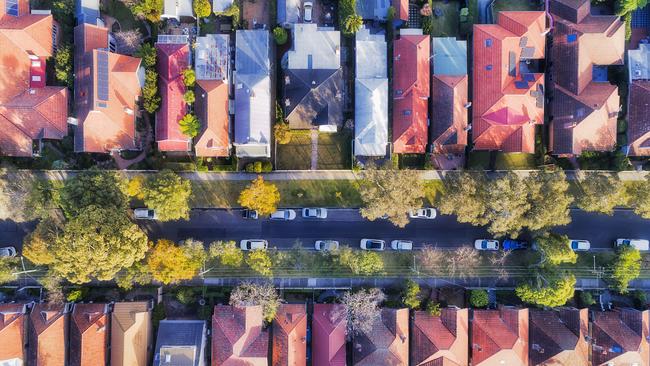Reality check for investors as rising rates put pressure on property

With a cliff looming for homeowners coming off fixed rate loans in the coming years, other borrowers are fiercely chasing better deals, with a 19.7 per cent jump in the volume of refinancing loans over the past 12 months, according to online property settlement company PEXA.
But as the cash rate moves higher, the options are becoming more limited.
A borrower coming off a 2 per cent fixed rate will immediately move to a variable rate somewhere between 3 to 3.5 per cent if they don’t shop around. And if they want to lock in a new fixed rate, they will pay even more, with current fixed rates sitting 1.5 to 2.5 per cent above rate variable rates, depending on the term.
For many, staying on a variable rate after their fixed term expires is the lesser of two evils, as they hope the RBA does not increase rates to the point where their variable rate is higher than the fixed rate they could have locked in.
For investors, there is another headwind to contend with.
While rental yields have increased nationally over the past 12 months, with SQM Research showing the average rental yield for an apartment rising 0.3 per cent to 4.1 per cent and the average house yield lifting 0.1 per cent to 3 per cent, the speed at which interest rates have risen has outpaced any benefit.
The pressure is felt most in Sydney and Melbourne, where average rental yields sit at about 2.5 per cent and 2.8 per cent respectively. This compares with 3.5 per cent in Brisbane, 3.8 per cent in Adelaide, 4.4 per cent in Perth, 3.7 per cent in Hobart and 3.8 per cent in Canberra.
All of these average rental yields are below the average four-year fixed investment loan rate of 5.5 per cent from the major banks, meaning that even before property expenses are taken into account, the average property investor today will experience a negative cash flow on their property if they borrow 100 per cent of the purchase price. Investors who enjoyed cash flow-positive properties in recent years while cash rates sat at record lows may now have to face the fact that their property is cash flow-negative, meaning they need to dip their hand into their own pocket each month to keep it going.
Self-managed super funds are not faring any better. Where the average variable interest rate on an investment property loan sits at around 3.5 per cent personally, the same loan for an SMSF is currently around 5 per cent.
More recent property investors, who may have never experienced negative cash flow before, will now certainly be feeling the pinch. And it is a double whammy for those who bought at the peak and are seeing their valuations erode as capital city property prices cool.
For many, having never had to contribute money into their investment property before, it will come as a rude shock to have to divert part of their take-home pay each month into their investment property loan.
And with interest rates likely to keep going up, the problem is only going to get worse. The flow-on impact is that as fed-up property investors head for the exits either voluntarily or due to mortgage stress, this may be a catalyst for property markets to drop even further, putting more pressure on investors riding out the pain.
However, some comfort can be found in the tax breaks afforded by negative gearing.
Australia is one of the few countries in the world that allows negative gearing, along with Japan and New Zealand.
The way that negative gearing works is that it rewards investors for losing money on their investments by giving them a tax break.
Many property investors have used it to their full advantage since its introduction in 1985. By claiming the losses on their investment properties as a tax deduction against their employment income, many have enjoyed a large annual tax refund.
Still, it has its critics, including Rich Dad Poor Dad author Robert Kiyosaki, who earlier this year said the Australian government should axe the tax break.
“I have another name for negative gearing: stupidity, it gives you a tax break for losing money, which makes no sense at all to me,” Mr Kiyosaki said at the time.
Others argue allowing investors to negatively gear properties pushes up prices as owner-occupiers have to compete with investors who get more tax benefits the higher property prices go via increased negative gearing benefits.
Another flow-on impact of rising interest rates and negative gearing will be on federal tax revenue. As interest rates continue to rise, the ATO will have to refund more money to investors who negatively gear their property investments.
Before the 2019 federal election, the Labor Party showed that the cost to Australian taxpayers of negatively geared investment properties was around $13bn per year. Given the concerns about rising federal deficits and the level of national debt, the upcoming increase in tax revenue lost due to negative gearing will be on the government’s radar.
However, given the catastrophic result the last time Labor tried to introduce changes to negative gearing under Bill Shorten as opposition leader, it is unlikely we will see any reform in this area in the upcoming October federal budget.
Remember, negative gearing only works long-term if property prices are rising. As you are losing money on a cashflow basis, you are in effect taking a bet that the property price will go up by more than the cash you need to put into the property each year net of negatively gearing benefits.
James Gerrard is principal and director of Sydney planning firm www.financialadvisor.com.au





Interest rates are on the rise and so are monthly mortgage repayments. Gone are the days of locking in a four-year fixed rate home loan at 1.99 per cent. Today, that same four-year fixed loan will cost you 5.5 per cent across the major banks.